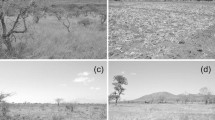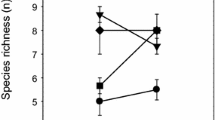Abstract
The Dakota skipper, Hesperia dacotae, (Hesperiidae) is an at-risk Lepidoptera species, limited in Canada to native mesic mixed-grass prairie habitat in Saskatchewan and Manitoba. Due to declines in the native mesic mixed-grass prairie the Dakota skipper population is threatened by loss of habitat. Currently, there is little knowledge about Dakota skipper and the availability and distribution of suitable habitat within Saskatchewan. Our objective was to map potential Dakota skipper habitat using a Generalized Linear Model (GLM) based species distribution model with climate, soil, and landscape predictor variables. Potential Dakota skipper habitat was found broadly in the mesic mixed-grass prairie region, however there is only ~217 km2 of potential habitat (probability of occurrence 0.7-1). Locations with high probability of occurrence had soils with a significantly higher soil ammonium (\({\rm {NH}}_{4}^{+}\)) and silt content than low probability locations. While the Dakota skipper is broadly distributed in native mesic mixed-grass prairie of southeastern Saskatchewan, environmental constraints likely restrict this species to a limited proportion of the intact native prairie. Implications for insect conservation: Mapping landscape-level species distributions will assist in the development of conservation and management plans for the Dakota skipper in southeastern Saskatchewan including targeted surveys for unknown populations in areas of high potential, identification of potential reintroduction sites, and selection of lands for conservation.


Similar content being viewed by others
References
Agriculture and Agri-Food Canada (2018) Detailed soil survey. Agriculture and Agri-Food Canada; Science and Technology Branch, Ottawa ON
Attanayake AU, Xu D, Guo X, Lamb EG (2019) Long-term sand dune spatio-temporal dynamics and endemic plant habitat extent in the Athabasca sand dunes of northern Saskatchewan. Remote Sens Ecol Conserv 5:70–86
Bailey AW, Schellenberg MP, McCartney D (2010) Management of Canadian prairie rangeland. Agriculture and Agri-Food Canada, Ottawa ON
Binzenhöfer B, Schröder B, Strauss B, Biedermann R, Settele J (2005) Habitat models and habitat connectivity analysis for butterflies and burnet moths – The example of Zygaena carniolica and Coenonympha arcania. Biol Conserv 126:247–259
Britten HB, Glasford JW (2002) Genetic population structure of the Dakota skipper (Lepidoptera: Hesperia dacotae): a North American native prairie obligate. Conserv Genet 3:363–374
Brotons L, Thuiller W, Araújo MB, Hirzel AH (2004) Presence-absence versus presence-only modelling methods for predicting bird habitat suitability. Ecography 27:437–448
COSEWIC (2014) COSEWIC assessment and status report on the Dakota Skipper Hesperia dacotae in Canada. Committee on the Status of Endangered Wildlife in Canada, Ottawa ON
Crone E, Schultz C (2003) Movement behavior and minimum patch size for butterfly population persistence. In: Boggs CL, Watt WB, Ehrlich PR (eds) Butterflies: ecology and evolution taking flight University of Chicago Press, Chicago. University of Chicago Press, Chicago, IL, pp 561–576
Dana RP (1991) Conservation management of the prairie skippers Hesperia dacotae and Hesperia ottoe: basic biology and threat of mortality during prescribed burning in spring. St, Paul, MN
Dearborn K, Westwood R (2014) Predicting adult emergence of Dakota skipper and Poweshiek skipperling (Lepidoptera: Hesperiidae) in Canada. J Insect Conserv 18:875–884
Delphey P, Runquist E, Nordmeyer C (2017) Plan for the controlled propagation, augmentation, and reintroduction of Dakota skipper. Legislative-Citizen Commission on Minnesota Resources, Minnesota
Ehrenreich JH, Aikman JM (1963) An ecological study of the effect of certain management practices on native prairie in Iowa. Ecol Monogr 33:113–130
Canada Environment (2007) Recovery strategy for the Dakota Skipper (Hesperia dacotae) in Canada. Environment Canada, Ottawa, ON
Fick SE, Hijmans RJ (2017) WorldClim 2: new 1-km spatial resolution climate surfaces for global land areas. Int J Climatol 37:4302–4315
Franklin J (2010) Mapping species distributions: spatial inference and prediction. Cambridge University Press, Cambridge, UK
Hall PW (2009) Sentinels on the wing: the status and conservation of butterflies in Canada. NatureServe Canada, Ottawa, ON
Hall PW, Catling PM, Lafontaine JD (2011) Insects at risk in the prairie region. Arthropods of Canadian grasslands. Biological Survey of Canada, Ottawa ON, pp 323–349
Hällfors MH, Liao J, Dzurisin J, Grundel R, Hyvärinen M, Towle K, Wu GC, Hellmann JJ (2016) Addressing potential local adaptation in species distribution models: implications for conservation under climate change. Ecol Appl 26:1154–1169
Hällfors MH, Vaara EM, Hyvärinen M, Oksanen M, Schulman LE, Siipi H, Lehvävirta S (2014) Coming to terms with the concept of moving species threatened by climate change—A systematic review of the terminology and definitions. PLOS One 9:e102979
Heikkinen RK, Luoto M, Kuussaari M, Toivonen T (2007) Modelling the spatial distribution of a threatened butterfly: impacts of scale and statistical technique. Landscape Urban Plann 79:347–357
Hooper RR (2003) Dakota Skipper (Hesperia dacotae) in Saskatchewan. Blue Jay 61:124–125
Klassen P (1989) The butterflies of Manitoba. University of Manitoba Press, Winnipeg MB
Layberry RA, Hall PW, Lafontaine JD (1998) The butterflies of Canada. University of Toronto Press, Toronto ON
Maes D, Ellis S, Goffart P, Cruickshanks KL, van Swaay CA, Cors R, Herremans M, Swinnen KR, Wils C, Verhulst S (2019) The potential of species distribution modelling for reintroduction projects: the case study of the Chequered Skipper in England. J Insect Conserv 23:419–431
McCabe TL (1981) The Dakota skipper, Hesperia dacotae (Skinner): range and biology, with special reference to North Dakota. J Lepidopter Soc 35:179–193
Pennock D, Bedard-Haughn A, Viaud V (2011) Chernozemic soils of Canada: genesis, distribution, and classification. Can J Soil Sci 91:719–747
Pohl GR, Schmidt BC, Lafontaine JD, Landry J-F, Anweiler GG, Bird CD (2014) Moths and butterflies of the Prairies Ecozone in Canada. In: Gibson DJ, Carmaco HA (eds) Arthropods of Canadian grasslands: biodiversity and systematics Part 2. Biological Survey of Canada, Ottawa, ON, pp 169–238
R Development Core Team (2018) R: A language and environment for statistical computing. R Foundation for Statistical Computing, Vienna, Austria
Royer RA, McKenney RA, Newton WE (2008) A characterization of non-biotic environmental features of prairies hosting the Dakota skipper (Hesperia dacotae, Hesperiidae) across its remaining US range. J Lepid Soc 62:1–17
Samson F, Knopf F (1994) Prairie conservation in North America. BioScience 44:418–421
Seidle KM (2018) Habitat characterization of Saskatchewan’s Dakota skipper, Hesperia dacotae, population. University of Saskatchewan, MSc.
Seidle KM, Lamb EG, Bedard-Haughn A, DeVink J-M (2018) Environmental associations of Hesperia dacotae (Lepidoptera: Hesperiidae) in southeastern Saskatchewan, Canada. Can Entomol 150:652–662
Swengel A, Swengel S (1999) Observations of prairie skippers (Oarisma poweshiek, Hesperia dacotae, H. Ottoe, H. leonardus pawnee, and Atrytone arogos iowa (Lepidoptera: Hesperiidae) in lowa, Minnesota, and North Dakota during 1988–1997. Great Lakes Entomol 32:267–292
Swengel AB (1996) Effects of fire and hay management on abundance of prairie butterflies. Biol Conserv 76:73–85
Swengel AB (2001) A literature review of insect responses to fire, compared to other conservation managements of open habitat. Biodiv Conserv 10:1141–1169
Thomas CD, Thomas JA, Warren MS (1992) Distributions of occupied and vacant butterfly habitats in fragmented landscapes. Oecologia 92:563–567
Thuiller W, Georges D, Engler R, Breiner F (2019) Package ‘biomod2’ Ensemble plantform for species distribution modeling
Vantieghem P, Maes D, Kaiser A, Merckx T (2017) Quality of citizen science data and its consequences for the conservation of skipper butterflies (Hesperiidae) in Flanders (northern Belgium). J Insect Conserv 21:451–463
Webster R (2003) 2002 Survey of the Dakota Skipper, Hesperia dacotae (Skinner) in Canada. Unpublished Report, COSEWIC
Webster R (2007) Dakota skipper, Hesperia dacotae (Skinner), surveys in southeast Saskatchewan and southwest Manitoba during 2007. Canadian Wildlife Service, Edmonton AB
Westwood AR, Blair D (2010) Effect of regional climate warming on the phenology of butterflies in boreal forests in Manitoba, Canada. Environ Entomol 39:1122–1133
Westwood R (2010) Survey for Dakota Skipper, Hesperia dacotae, in central, south eastern and south western Manitoba and south eastern Saskatchewan in 2010. Winnipeg, MB
Westwood R, Westwood AR, Hooshmandi M, Pearson K, LaFrance K, Murray C (2020) A field-validated species distribution model to support management of the critically endangered Poweshiek skipperling (Oarisma poweshiek) butterfly in Canada. Conserv Sci Pract 2:e163
Zhang MC, Karamanos RE, Kryzanowski LM, Cannon KR, Goddard TW (2002) A single measurement to predict potential mineralizable Nitrogen. Comm Soil Sci Plant Anal 33:3517–3530
Zhou X, Huang G, Wang X, Cheng G (2018) Dynamically-downscaled temperature and precipitation changes over Saskatchewan using the PRECIS model. Clim Dynam 50:1321–1334
Acknowledgements
Funding support for this research came from a NSERC Industrial Postgraduate Scholarship in partnership with Stantec Consulting Limited to KS, a NSERC Engage grant to ABH, and grants from NSERC (Discovery Grant), Environment and Climate Change Canada, and the Nature Conservancy of Canada to EGL.
Author information
Authors and Affiliations
Corresponding author
Ethics declarations
Conflict of interest
The authors declare that they have no conflict of interest.
Ethics approval
Animal care permitting was not required for insect work.
Additional information
Publisher's Note
Springer Nature remains neutral with regard to jurisdictional claims in published maps and institutional affiliations.
Electronic supplementary material
Below is the link to the electronic supplementary material.
Rights and permissions
About this article
Cite this article
Seidle, K.M., Kiss, J., Attanayake, A.U. et al. Extent of Dakota skipper, Hesperia dacotae, distribution in Southeastern Saskatchewan, Canada. J Insect Conserv 24, 1073–1081 (2020). https://doi.org/10.1007/s10841-020-00276-6
Received:
Accepted:
Published:
Issue Date:
DOI: https://doi.org/10.1007/s10841-020-00276-6




